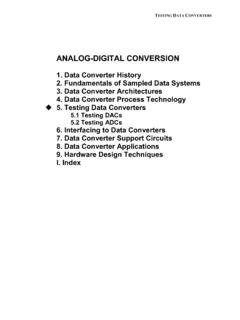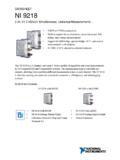Transcription of Serial LVDS High-Speed ADC Interface - Xilinx
1 XAPP524 ( ) November 20, 1 Copyright 2012 Xilinx , Inc. Xilinx , the Xilinx logo, Artix, ISE, Kintex, Spartan, Virtex, Vivado, Zynq, and other designated brands included herein are trademarks of Xilinx in the United States and other countries. All other trademarks are the property of their respective application note describes a method of utilizing dedicated SelectIO technology deserializer components (ISERDESE2 primitives) in 7 series FPGAs to Interface with analog -to- digital converters (ADC) with Serial , low-voltage, differential signalling (LVDS)
2 Associated reference design illustrates a basic LVDS Interface connecting a Kintex -7 FPGA to an ADC with High-Speed , Serial LVDS High-Speed ADCs used today have a resolution of 12, 14, or 16 bits with possible multiple converters in a single package. Each of the converters in the package can be used in standalone mode or converters in the package can be combined and used in an interleaved mode to double or quadruple the conversion (sample) both standalone mode or interleaved mode, one or two physical Serial outputs can be used as a connection to the interfacing device.
3 One set of differential outputs is called a data lane. Using one data lane means that the converter is used in 1-wire mode and two data lanes are called 2-wire mode. For every possible data output combination there is always one High-Speed bit clock and one sample rate frame clock 1-wire mode is used in SDR and DDR configurations and 2-wire mode uses only DDR 1-wire mode keeps the amount of interconnections low and uses normally one data lane per converter in a package. Secondly, the 1-wire mode can be used to output data of one or two converters in an interleaved of two converters using a 1-wire setup: One converter outputs data on the rising edge of the bit clock and the second converter uses the falling clock edge.
4 This immediately doubles the bit clock rate and is therefore not much 2-wire mode doubles the amount of connections between the ADC and interfacing device, but has the great advantage to divide the bit clock by single converter can double the sample clock rate while the bit clock doesn't change frequency or a converter can keep its sample clock rate while the bit clock gets divided by two. In both cases the data is output in interleaved format over two data FPGA s SelectIO technology deserializer components are configured as ISERDESE2 primitives.
5 Two ISERDESE2s in single data rate (SDR) mode are used to capture a double data rate (DDR) signal. One ISERDESE2 is clocked at the rising edge and the second at the falling edge of the bit clock (CLK). This method allows capturing up to 16 bits, each ISERDESE2 can capture 8 Note: 7 Series FPGAsXAPP524 ( ) November 20, 2012 Serial LVDS High-Speed ADC InterfaceAuthor: Marc DefossezFPGA ResourcesXAPP524 ( ) November 20, 2 FPGA ResourcesThe 7 series FPGAs have high-range (HR) and high-performance (HP) I/O banks. Important for ADC interfaces is that ISERDESE2 (Figure 1) and IDELAYE2 (Figure 2) components are available in both HR and HP banks.
6 The HR I/O banks support LVDS I/O and HP banks support LVDS at (VCCO level). For details about these HR and HP I/O banks and the ISERDESE2 and IDELAYE2 components, see UG471, 7 Series FPGAs SelectIO Resources User LVDS InterfaceMany ADCs use a serialized LVDS Interface to provide digital data over one or two LVDS channels per ADC in the component package to the FPGA. Figure 3 shows the analog input signal along with the input, bit, and frame clocks. Sample N of the analog signal is converted to digital format and presented at the ADC outputs after a latency period.
7 The analog signal is converted into a digital , Serial data stream with 12-bit ADC resolution that is provided together with a High-Speed bit clock and a sync or frame Target - Figure 1 Figure 1:ISERDESE2X-Ref Target - Figure 2 Figure 2:IDELAYE2 INTERFACE_TYPE : string := "NETWORKING";SERDES_MODE : string := "MASTER";DATA_WIDTH : integer := 8;DATA_RATE : string := "DDR ;OFB_USED : string := "FALSE";IOBDELAY : string := "NONE";NUM_CE : integer := 2;DYN_CLKDIV_INV_EN : string := "FALSE";DYN_CLK_INV_EN : string := "FALSE";INIT_Q1 : bit := '0';INIT_Q2 : bit := '0';INIT_Q3 : bit := '0';INIT_Q4 : bit := '0';SRVAL_Q1 : bit := '0';SRVAL_Q2 : bit := '0';SRVAL_Q3 : bit := '0';SRVAL_Q4 : bit := '0'ISERDESE2 SHIFTIN1 SHIFTIN2 OFBDDDLYCE1CE2 RSTBITSLIPCLKCLKBCLKDIVCLKDIVPDYNCLKDIVS ELDYNCLKSELOCLKOCLKBOQ1Q2Q3Q4Q5Q6Q7Q8 SHIFTOUT1 SHIFTOUT2X524_01_012912 CINVCTRL_SEL : string := FALSE ;DELAY_SRC : string := IDATAIN ;HIGH_PERFORMANCE_MODE : string ;= FALSE ;IDELAY_TYPE : string := FIXED.
8 IDELAY_VALUE : integer := 0;PIPE_SEL : string := FALSE ;REFCLK_FREQUENCY : real := ;SIGNAL_PATTERN : string := data ISERDESE2 DATAINIDATAINCNTVALUEIN [4:0]CEINCLDLDPIPEENREGRSCCINVCTRLCNTVAL UEOUT [4:0]DATAOUTX524_02_012912 ADC LVDS InterfaceXAPP524 ( ) November 20, 3 The frame clock (FCLK) is a digitized and phase-shifted version of the ADC sample clock. FCLK is phase aligned with the Serial data , and all data bits of a sample fit into one frame clock period. The High-Speed bit clock (DCLK) is presented as a 90 phase-shifted signal to the data and 1-wire mode, there are as many data channels as converters in the package.
9 In 2-wire mode, the data is split over two data channels per converter. The frequency of DCLK is determined by the ADC's resolution and sample rate. Therefore, an ADC provides one or two data lanes per converter in the package, but only one DCLK and one maximum speed of the LVDS I/O is set by the maximum possible speed that DCLK can toggle the flip-flops in the FPGA logic or in the ISERDESE2. Therefore, the maximum sample speed of a single-channel LVDS ADC with 1-wire Interface is 1 calculates the bit clock rate for a single ADC in 1-wire DDR mode.
10 For example, the bit clock frequency of a 16-bit, 1-wire mode, 150 Ms/s device is (16 150) / 2 = 1,200 MHz, corresponding to a Gb/s bit rate. These physical single data lane (1-wire) and clock rates are too high for the LVDS I/O in any FPGA speed grade. The 2-wire Interface solution uses two physical data lanes (2-wire) per ADC, thereby doubling the data throughput rate while lowering the bit clock rate. Equation 1 When the single data lane, 16-bit, 150 Ms/s ADC is used in 2-wire mode (two physical data lanes per ADC), the bit clock rate becomes 600 MHz as Equation 2 shows.














